Attracting a Crowd
The October 2014 study published by The Wallace Foundation, entitled The Road To Results: Effective Practices For Building Arts Audiences, seeks to take some of the guesswork out of choosing the right answers to your organization’s particular audience-building riddles by examining the examples of ten arts organizations. What can you learn from this report? Read on here.
NEA Report: Reading Between the Lines
Every decade the National Endowment for the Arts conducts large-scale quantitative research on
audiences, providing a compendium of longitudinal information on
audience behavior. How do we interpret and use this wealth of
information? What do you need to know to participate in this ongoing conversation in the field? Read on here for more.
A Philosophy Major Rants on Dance as a Pyramid Scheme
Responding to the commentary “Is American Modern Dance a Pyramid Scheme?” Nancy Wozny writes: Not everyone has the
mettle to navigate the difficulty of being an
artist, but I have yet to meet one person who wants to live in a world
without art. So the question remains as educators, practitioners, and
citizens of this dance world, how can we go forward without the burden
of old paradigms of success? Read on here for more.
A Call For R/evolution
More on Sarah Austin’s recent controversial Dance/USA article, “Is American Modern Dance a Pyramid Scheme?”
as the conversation continues in From the Green Room. Jennifer Edwards contends this issue in the dance field is a symptom of a larger cultural, socio-economic shift that continues
to affect both the arts and education. This is a shift in the perceived
and broadcasted value of learning, experience, and critical thinking.
A Letter to My Former Student
Recently, an article by the erudite and whip-smart Sarah Anne Austin
(B.A. Dance, University of Maryland, 2008) touched off heated discussion in the
academic dance world. The piece, “Is American Modern Dance a Pyramid Scheme?” riled every raw nerve in every dance alum from every dance
program across these United States. Read what Austin’s professor, Karen Bradley, has to say about studying dance in today’s colleges.
How Much Arts Journalism Is Too Much Arts Journalism?
Anecdotal and other reports note the obvious: classical dance audiences
are aging and declining, and new work seems to have a hard time gaining
consistent audiences. Many of us agreed on the need to develop
audiences, and out of those conversations author Robert Bettmann, who founded a small arts magazine, Bourgeon to help artists develop audiences. But the question arises: are publications like these part of hte problem or solution in engaging new and existing audiences.
Preparing for the Unthinkable
How does an organization plan for a tragedy? You really can’t. You plan for your
organization’s response to one by putting into place the
information, guidelines, training, and materials needed to help company
leadership and staff deal with a most difficult and often chaotic time.
Writer Steve Sucato contacted Sarasota Ballet, Alvin Ailey American Dance
Theater, Culture Shock Dance Chicago, and Chicago Dance Crash about those company members they lost recently. Their
insight and advice may prove useful in preparing your organization for
the unthinkable.
LEADERSHIP CORNER: Katherine Brown, Executive Director, New York City Ballet
With this interview, From the Green Room inaugurates a new series, the Leadership Corner, featuring one-on-one conversations with top leaders in the dance field. Katherine Brown is executive director of New York City Ballet,
and in that capacity oversees the management and administrative
functions of the ballet and the David H. Koch Theater and manages a
budget of approximately $77 million.
Is American Modern Dance a Pyramid Scheme?
Two million arts graduates in the United States have bachelor’s degrees in the visual and performing arts, though fewer than 10 percent make enough money to live as working artists. Most arts graduates work in non-arts fields — the ubiquitous “day job” that they are encouraged, rightly, not to quit, especially given the cost of an arts degree. Are we perpetuating a myth, or a pyramid scheme, by continuing to promote and accept students into dance and performing arts departments? Read Sarah Anne Austin’s article for more.



How To Pick a College Dance Program That Will Work for You
High school dancers — and parents — wondering what to look for in a college or university dance program? Ashley Thorndike-Youssef has some ideas and talking points to use on you college tours as you begin your process of narrowing down the right school for you. Not a matriculating at a college? This material is a anecdote of sorts to the ongoing discussions on academic dance programs as a pyramid scheme. Read on for more, exclusively in From the Green Room, Dance/USA’s eJournal.